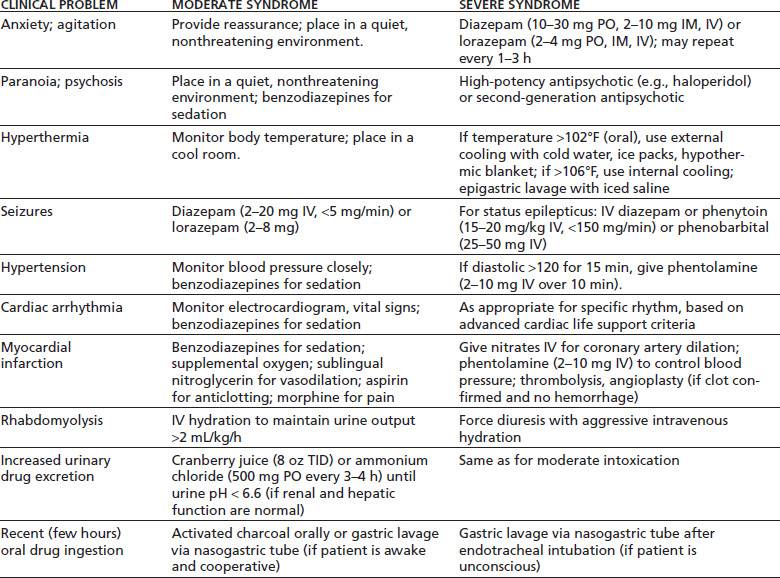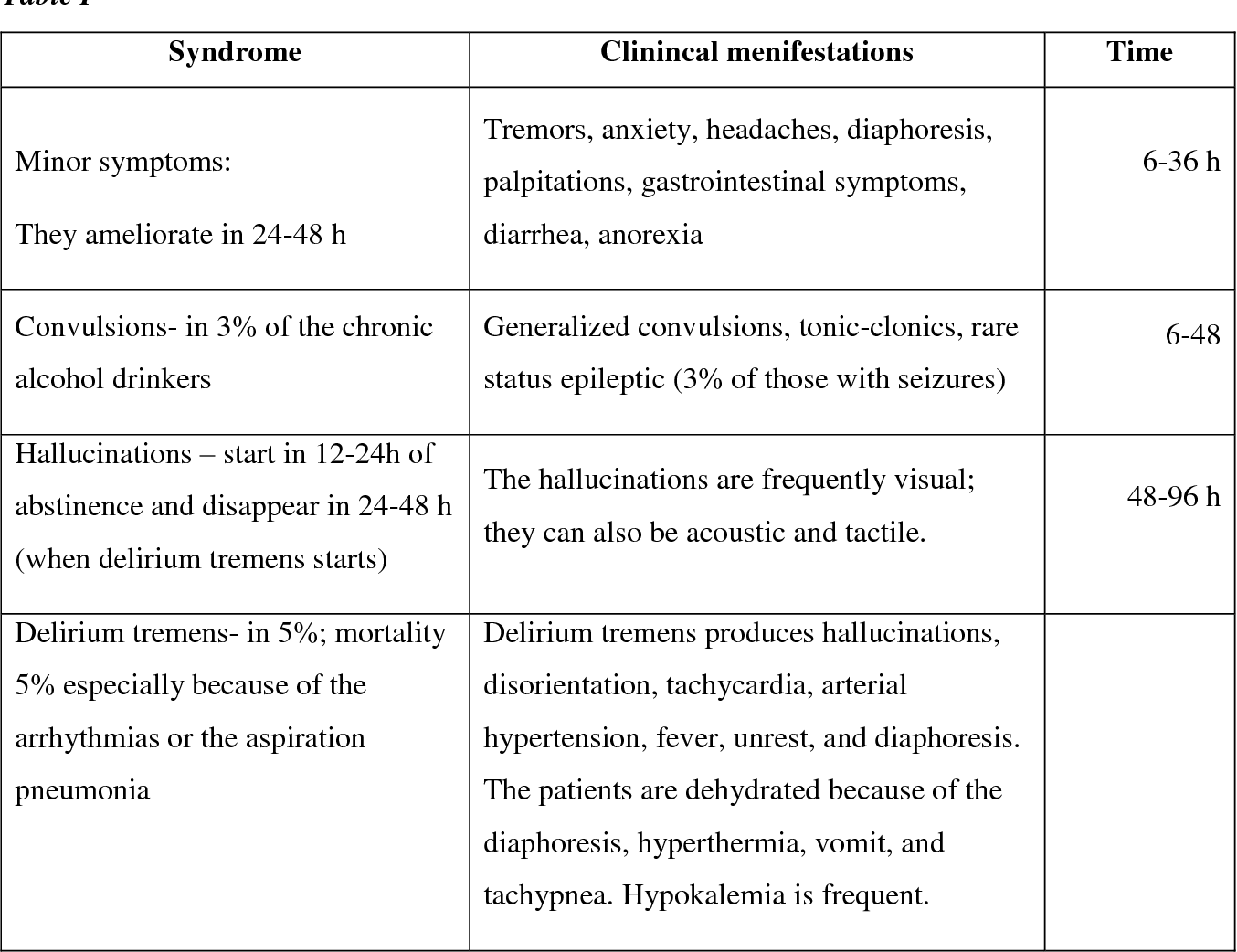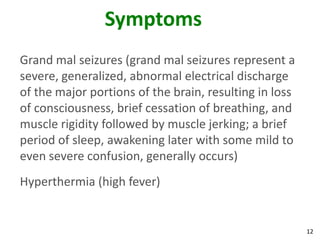Convulsions and Hyperthermia Are Symptoms of Withdrawal From
Substance withdrawal may be distinguished from a substance discontinuation syndrome by the absence of drug craving in the latter. Withdrawal from what class results in increased psychomotor activity agitation muscular weakness hyperthermia diaphoresis delirium convulsions elevated BP elevated pulse rate temp eyelid tremors.

Management Of Stimulant Hallucinogen Marijuana Phencyclidine And Club Drug Intoxication And Withdrawal Basicmedical Key
The seizures occur predominantly in patients with a long history of chronic alcoholism as evidenced by their.

. They peak on day 2 and by day 4 or 5 the symptoms have usually improved significantly. Withdrawal occurs most frequently and severely with short- to intermediate-acting barbiturates such as butalbital. They might include to following- Headaches.
As mentioned above some of these withdrawal symptoms can be fatal. This is a medical emergency. Withdrawal though they may be seen in major withdrawal or full-blown delirium tremens.
Ongoing withdrawal may lead to hallucinations delirium seizures and muscle rigidity. Hyperthermia is an immediate threat to life may cause brain injury rhabdomyolysis and disseminated intravascular coagulation. A humans normal body temperature is about 986 degrees Fahrenheit.
Tremens DTs also known as alcohol withdrawal delirium in the DSM-IV is a significant complication of alcohol withdrawal. Treatment is supportive with pheno-barbital intravenously until symptoms resolve. It is proposed that removal of GABAergic inhibitory tone within the CNS is responsible for the hypertension tachycardia diaphoresis tremors hyperthermia and seizures observed during withdrawal.
Symptoms of hyperthermia or heat-related illness vary according to the specific type of illnessThe most severe form of hyperthermia is heat strokeThis happens when the body is no longer able to regulate its internal temperature. The clonic phase of a withdrawal seizure exhibits symptoms such as. Rhythmic but sometimes violent contractions of the arms andor legs.
45 For example discontinuation symptoms ncbinlmnihgov Clinicians should not confuse GAD with specific phobias which have much more acute and traumatic symptoms. The first symptoms to appear are commonly an increase in nervousness and anxiety along with heavy constant sweating. Good clinical judgment is mandatory when dealing with these situations to decide when to and when not to treat the patient.
Agitation tachycardia confusion dilated and reactive pupils ataxia hypertension rigidity or agitation sweating catatonia Severe. 85 If left untreated withdrawal from ITB can progress to rhabdomyolysis profound autonomic instability multisystem organ failure cardiac arrest and death within 13 days. Because very severe symptoms can arise unexpectedly inpatient detox is the safest route for alcohol-dependent individuals who want to quit.
Hyperthermia may be defined roughly as a temperature above 104 F40 C in this context. Assessment of alcohol withdrawalDTs can. 7475788284 Severe baclofen withdrawal syndrome can mimic sepsis malignant.
Delirium tremens an experience that includes global confusion hallucinations and profound agitation It may also be accompanied with a rapid heart rate elevated blood pressure and hyperthermia. Withdrawal symptoms will vary and range from mild to severe. While you are more likely to experience more common symptoms of alcohol withdrawal such as.
Long-acting benzodiazepines are the treat-ment of choice. Seizures can be dangerous and the delirium some users experience can lead to agitation hyperthermia and cardiovascular failure. Withdrawal seizures Withdrawal-associated seizures are generalized tonic-clonic convulsions that usually occur within 12 to 48 hours after the last alcoholic drink but reportedly sometimes occur after as few as two hours of abstinence.
How Long Does Barbiturate Withdrawal Last. Any body temperature above 99 or 100 degrees Fahrenheit is too warm. Hyperthermia rigidity tremor autonomic dysfunction altered mental status Mild.
- DTs are characterized by hallucinations diaphoresis hyperthermia tremors and other signs of sympathetic hyperactivity. Minor withdrawal symptoms can appear 6-12 hours after alcohol stopped. Symptoms of alcohol withdrawal and the risk of experiencing delirium tremens can last up to 5-7 days.
Symptoms typically present about 8 hours after a significant fall in blood alcohol levels. Hyperthermia is usually the result of overexertion in hot humid conditions. Depending on the seriousness of the addiction symptoms may start within hours following the last drink.
The clonic phase is next and is what most people think of when they imagine seizures. Once they start they may last days weeks or in extreme cases months. Barbiturate withdrawal symptoms include hypertension tachycardia hyperthermia agi-tation hallucinations nausea vomiting and seizures.
Anxiety fatigue sweating vomiting depression seizures hallucinations withdrawal comes with severe syntpoms and like alcohol can be damaging to the fetus Alcohol withdrawal. The timeline for barbiturate withdrawal is different for each person. Agitated delirium positional asphyxia hyperthermia and seizures.
Flexing at the waist or hips. Hyperthermia occurs when your body absorbs or generates more heat than it can release. Hyper- or hypothermia rigidity autonomic dysfunction rhabdomyoly-sis coma seizures.
The shakes or tremors. Minor alcohol withdrawal begins as early as 6 hours and peaks at 2436 hours after cessation or reduction in alcohol intake. Most forms of hyperthermia are preventable.
Hyperthermia is due to excessive thermal generation from muscle activity not to hypothalamic changes in the set point. Relieve anxiety irritability tension seizure disorders and induce anesthesia. The above signs are just the tonic phase of the seizure.
The clinical problem is in differentiating symptoms associated with opiate withdrawal from symptoms that may reflect an underlying medical illness. Other patients withdrawing from stimulants may have severe cravings paranoia suicidal ideations exhaustion and other symptoms. Within 2 to 4 days of last benzo use withdrawal symptoms will begin to appear.
It requires aggressive management to facilitate positive patient outcomes. Minor withdrawal is characterized by mild autonomic hyperactivity manifested by nausea anorexia coarse tremor tachycardia hypertension hyperreflexia anxiety and sleep disturbances. Patients experiencing opioid withdrawal can usually provide an accurate history of their usual dose of the timing of their last dose and of any other current symptoms.

Symptom Of Opioid Withdrawal Time From Last Use A Withdrawal Symptoms Download Table

Treating Delirium Agitation In The Emergency Room 2015 Eb Medicine Endocrine Disease Emergency Room Intracranial Pressure

Alcohol Withdrawal Therapeutical Management In Surgical Patients With Upper Intestinal Bleeding Semantic Scholar

البورد العراقي للصيدلة السريرية Treatment Of Drug Induced Hyperthermeia Immediate Rapid Cooling Is Essential 1 Maintain The Airway And Assist Ventilation If Necessary 2 Administer Glucose Containing Iv Fluids And Give

Drugs Commonly Known To Cause Hyperthermia And Associated Muscle Rigidity Download Scientific Diagram

Figure 1 Conduct Disorder Neonatal Abstinence Syndrome Nicu Nurse

Substance Use Intoxication And Withdrawal In The Critical Care Setting Semantic Scholar

Ati Flash Cards 05 Medications Affecting The Nervous System Pharmacology Nursing Nursing Flashcards Nervous

Pathophysiology Underlying Drug Induced Hyperthermic Syndromes Mh Download Scientific Diagram

Ppt Substance Withdrawal Powerpoint Presentation Free Download Id 2967253

Major Syndromes And Causes Of Hyperthermia Due To Toxicity Download Table

Seizure Joint Ems Protocols Nursing School Survival Emt Study Emergency Medical Technician

Outpatient Management Of Alcohol Withdrawal Syndrome American Family Physician

Differential Diagnosis And Specific Treatment In Syndromes Associated Download Table





Comments
Post a Comment